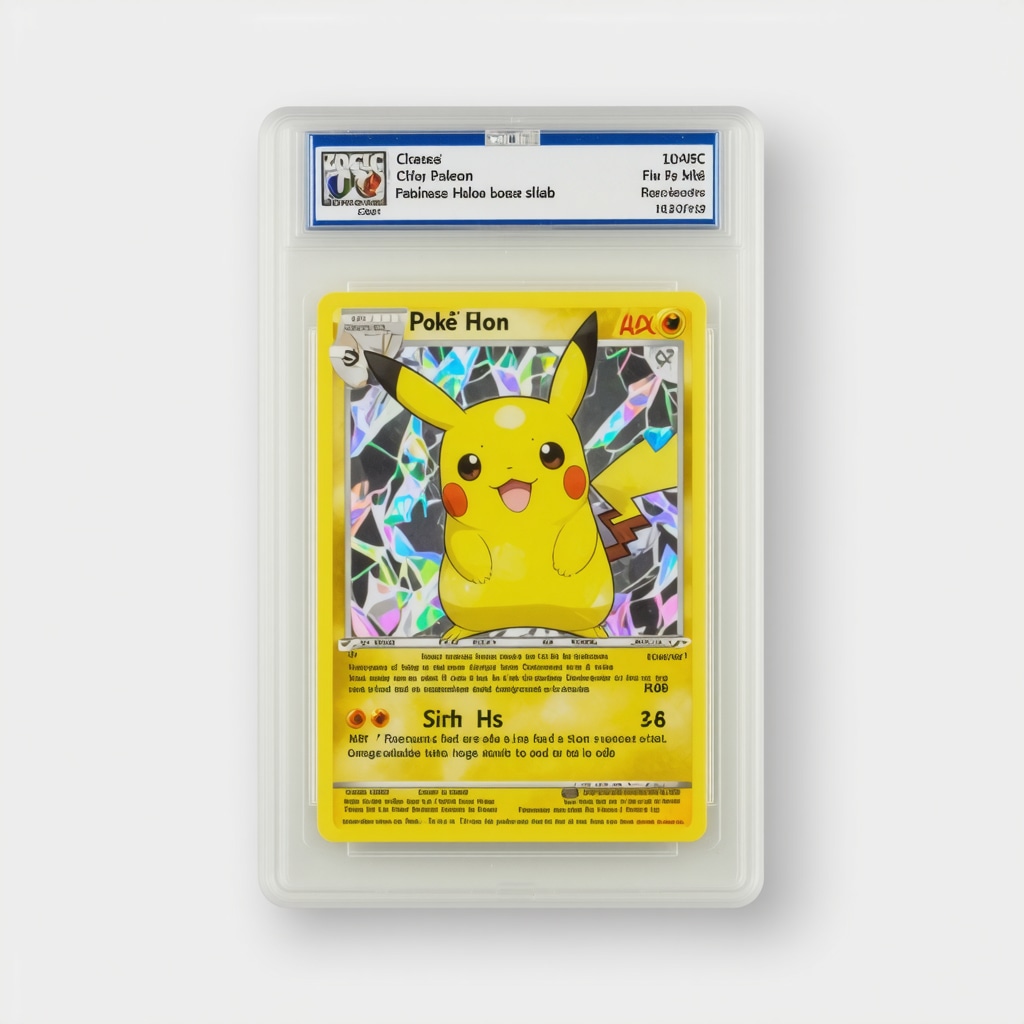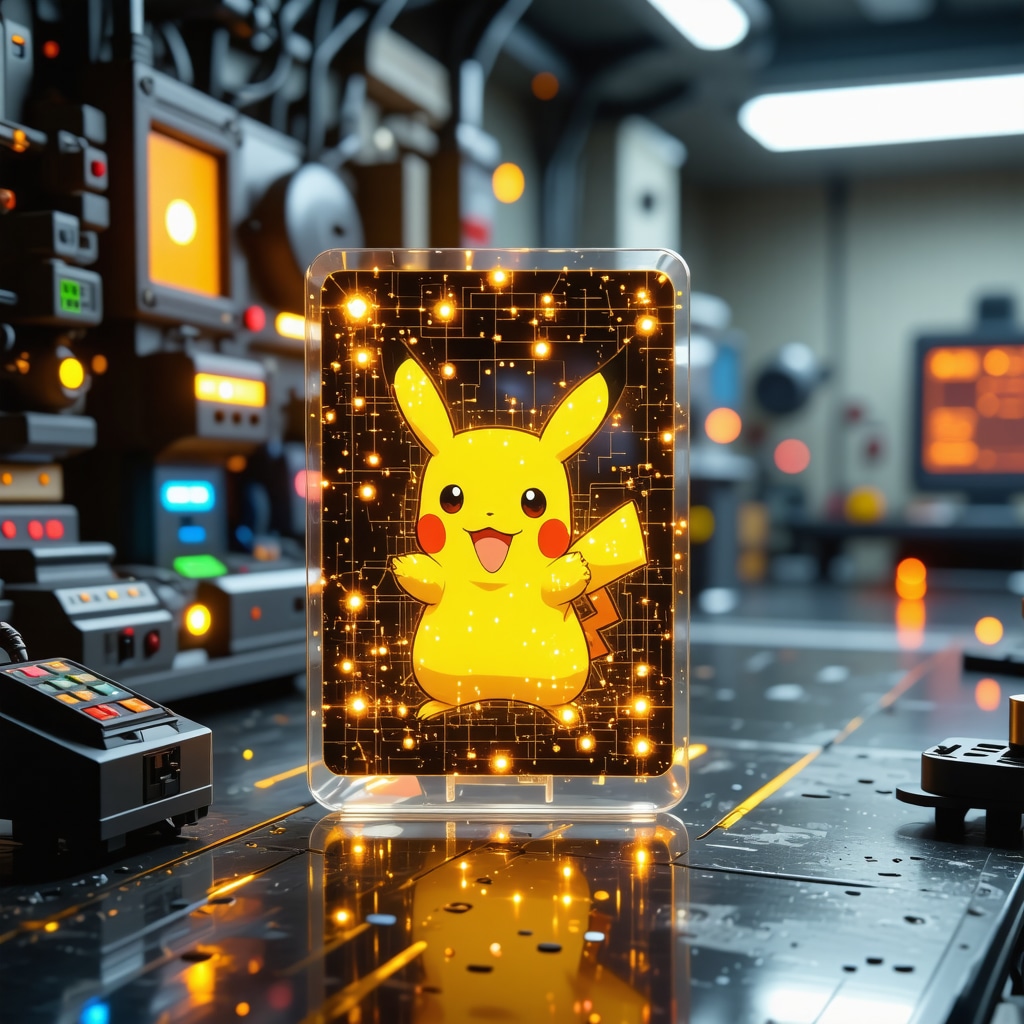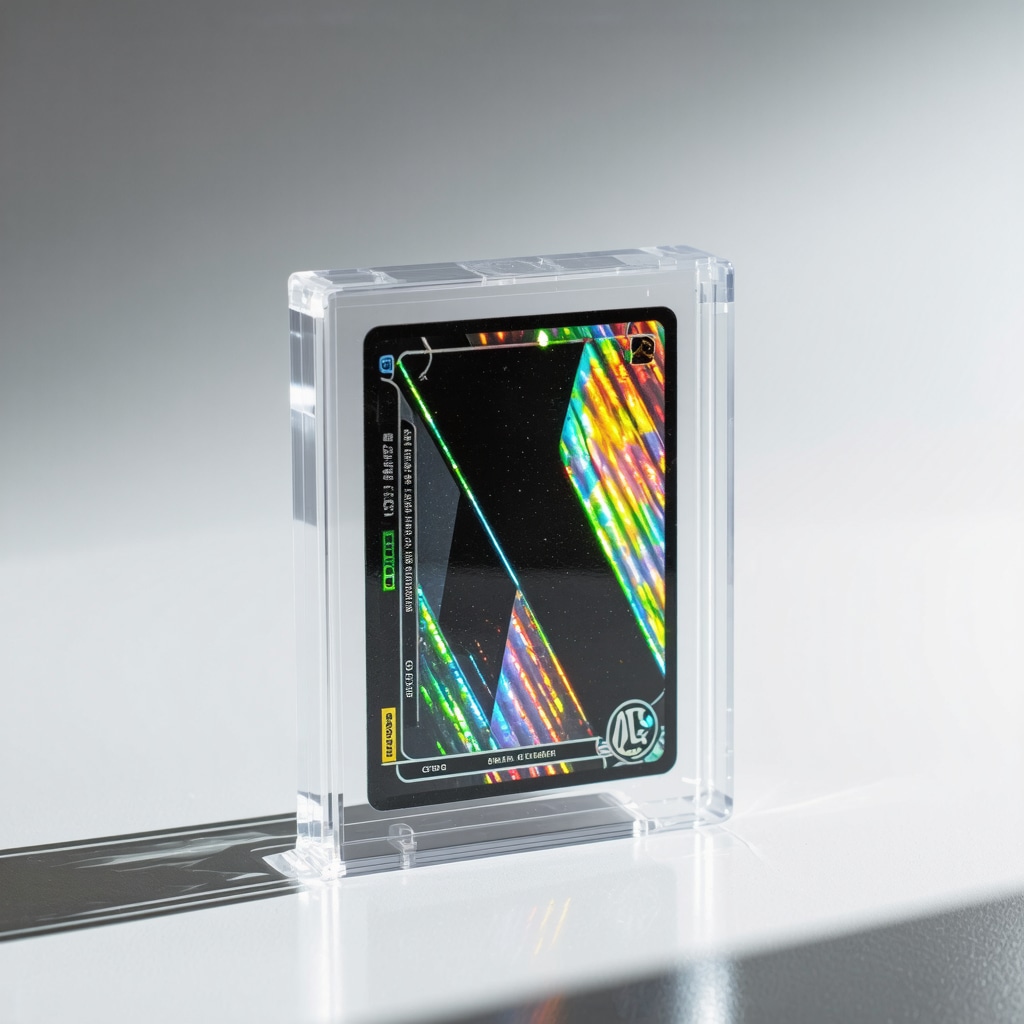Decoding the Allure of CGC Graded Japanese Holo Cards
In the dynamic world of Pokémon card collecting, CGC graded Japanese holo cards have carved out a niche prized for their rarity, condition assurance, and investment potential. Unlike ungraded cards, these certified collectibles offer a transparent window into quality, authenticated by the Certified Guaranty Company (CGC), a respected authority in card grading. The unique holographic effects on Japanese cards combined with CGC’s stringent grading standards elevate these cards beyond mere memorabilia, positioning them as coveted assets in both hobbyist and investor circles.
Unlocking the Nuances of CGC Grading for Japanese Holo Cards
CGC grading encompasses a meticulous evaluation of a card’s centering, edges, surface, and corners, culminating in a numeric grade from 1 to 10. However, what sets CGC apart in the Japanese holo card realm is their specialized criteria that account for the distinct production techniques and cultural printing nuances native to Japanese cards. This means collectors receive a grade that reflects not only physical condition but also authenticity against sophisticated counterfeits prevalent in the market.
How Does CGC Grading Impact the Value of Japanese Holo Cards?
Value fluctuation in graded Japanese holo cards hinges significantly on their CGC score. A Gem Mint 10 grade is the zenith, signaling flawless condition and commanding premium prices that can exponentially exceed ungraded counterparts. For example, a CGC 10 Japanese Charizard holo card from the Base Set can see its market value soar due to verified pristine condition, a factor crucial for long-term investment strategies. Additionally, the encapsulation and tamper-evident slab provide collectors peace of mind, safeguarding their prized possessions.
Practical Tips for Navigating the CGC Graded Japanese Holo Market
Engaging with CGC graded Japanese holo cards requires a blend of market savvy and an eye for detail. Collectors should prioritize buying from reputable sources and familiarize themselves with CGC’s grading standards to discern genuine high-grade cards effectively. Leveraging resources such as decoding CGC grading standards for Japanese Pokémon cards can empower buyers to make informed decisions, avoiding pitfalls of overpaying or falling prey to counterfeit slabs.
The Intricacies Behind Japanese Holo Card Production and Its Influence on Grading
Japanese holo cards often feature distinctive printing methods, including foil layering and unique holo patterns that differ from their English counterparts. These intrinsic characteristics affect how graders assess surface quality and centering. Understanding these subtleties allows collectors to appreciate why certain imperfections may be acceptable in grading contexts specific to Japanese holo cards, emphasizing the importance of expert grading services like CGC in maintaining fair, standardized evaluations.
Why Trust CGC? Authority and Transparency in Grading
CGC’s reputation as a trusted third-party grader is underpinned by their rigorous grading protocols and transparent reporting. Their detailed subgrades provide collectors with granular insights into the card’s condition beyond the overall numeric grade. This transparency builds confidence in market transactions, an essential factor given the high stakes involved with rare Japanese holo cards. For further authoritative insights, CGC’s official grading methodology is publicly documented, offering collectors direct access to grading criteria and procedural integrity.
Engage with the Community: Share Your CGC Graded Japanese Holo Card Experiences
Have you recently acquired a CGC graded Japanese holo card or successfully navigated the grading process? Share your stories and tips in the comments to foster a knowledgeable and supportive collector community. For personalized advice and detailed inquiries, consider reaching out via contact us. Your insights could illuminate the path for both novice and seasoned collectors alike.
Exploring the Impact of Market Trends on CGC Graded Japanese Holo Cards
Beyond intrinsic card quality, market trends heavily influence the value trajectory of CGC graded Japanese holo cards. Factors such as nostalgia waves, competitive play popularity, and media exposure can create spikes in demand. For instance, the resurgence of vintage Pokémon card interest in 2023 led to a noticeable increase in CGC 10 Japanese Base Set card prices, underscoring the symbiotic relationship between cultural phenomena and collectible valuations. Staying attuned to these trends is crucial for collectors and investors aiming to optimize their acquisition timing and portfolio diversification.
Mastering Authentication: How CGC Ensures Credibility in the Face of Sophisticated Forgeries
With counterfeit Japanese holo cards becoming increasingly sophisticated, CGC’s authentication protocols have evolved to incorporate advanced forensic techniques. This includes detailed ultraviolet light inspections, microscopic surface texture analysis, and cross-referencing with proprietary databases of known counterfeits. These measures, combined with the encapsulation in tamper-evident slabs, significantly mitigate risks for collectors. Understanding this authentication rigor helps buyers appreciate why CGC graded cards command a premium over ungraded or uncertified counterparts.
What Are the Subtle Differences Between CGC Pristine 10 and Gem Mint 10 Grades on Japanese Holo Cards?
While the numerical grading scale might suggest a straightforward hierarchy, the nuanced distinctions between CGC Pristine 10 and Gem Mint 10 grades are pivotal for collectors. Pristine 10 indicates near-flawless condition with minor acceptable imperfections that do not detract from overall eye appeal. Gem Mint 10, however, represents absolute perfection with no discernible flaws under magnification. These distinctions not only influence market pricing but also impact long-term value retention and liquidity. For a deep dive into these differences, resources like navigating CGC grading Pristine 10 vs Gem Mint 10 Japanese Pokémon provide invaluable expert guidance.
Leveraging CGC Graded Japanese Holo Cards as Strategic Investments
Strategic investment in CGC graded Japanese holo cards requires an understanding that extends beyond card condition into market demand cycles and rarity factors. Cards graded CGC 10 from highly sought-after sets like the Japanese Base Set or the VSTAR Universe series often exhibit resilient price appreciation. Investors benefit from tracking auction results and market analytics to identify undervalued gems before demand surges. The integration of CGC grading adds liquidity and trust, enabling easier portfolio diversification and exit strategies.
How Does CGC Grading Influence Collector Behavior and Market Liquidity?
CGC grading has transformed collector behavior by introducing standardized quality assurance, which in turn enhances market liquidity. Collectors are more willing to trade or sell CGC graded cards due to the reduced uncertainty regarding card condition and authenticity. This standardization fosters a transparent marketplace where price discovery aligns closely with objective condition assessments. Consequently, CGC graded Japanese holo cards often command narrower bid-ask spreads and experience faster turnover in secondary markets.
Expanding Your Collection: Where to Source Authentic CGC 10 Japanese Holo Cards
Sourcing authentic CGC 10 Japanese holo cards requires vigilance and access to reputable marketplaces. Trusted platforms and verified sellers specializing in graded cards provide safer avenues for acquisition. Engaging with communities and utilizing guides such as where to find CGC Gem Mint 10 Japanese Pokémon cards on eBay can significantly enhance your buying strategy. Additionally, attending live auctions or professional conventions offers opportunities to inspect cards firsthand, ensuring authenticity and condition meet expectations.
Advancing Your Expertise: Recommended Resources and Community Engagement
To deepen expertise in the CGC graded Japanese holo niche, collectors should engage with authoritative resources and community discussions. Exploring articles such as mastering CGC 10 Japanese full art trainer secret rare insights provides detailed knowledge on specific card types and grading nuances. Active participation in forums and social media groups fosters knowledge exchange, helping collectors stay updated on market developments, grading refinements, and investment tips.
We invite you to share your experiences or ask questions about CGC graded Japanese holo cards in the comments below. Your input enriches the community and supports informed collecting decisions.
For further expert guidance or personalized assistance, do not hesitate to contact us.
According to the Certified Guaranty Company official grading methodology, the integrity and precision in grading are foundational to maintaining collector confidence and market stability, especially in high-stakes collectibles like Japanese holo Pokémon cards.

Pioneering Authentication: CGC’s Cutting-Edge Techniques to Combat Forgery in Japanese Holo Cards
As the market for CGC graded Japanese holo cards continues to thrive, so too does the sophistication of counterfeiters striving to mimic these prized collectibles. CGC has responded with a multi-faceted authentication approach that transcends traditional visual inspections. Their arsenal now includes advanced forensic methods such as hyperspectral imaging, which reveals subtle discrepancies in ink composition and foil layering unique to authentic Japanese holo cards. Complementing this is the deployment of machine learning algorithms trained on thousands of genuine and fake card images, enabling rapid and highly accurate identification of anomalies invisible to the naked eye.
Moreover, CGC’s integration of blockchain technology into their certification process enhances traceability and tamper-evidence, ensuring the provenance of each graded card is immutable and easily verifiable by collectors and investors worldwide. This fusion of science and technology not only fortifies collector confidence but also raises the bar for industry-wide grading standards.
How Does CGC’s Use of Hyperspectral Imaging Improve Authentication Accuracy for Japanese Holo Cards?
Hyperspectral imaging allows CGC experts to analyze the spectrum of light reflected from a card’s surface across numerous wavelengths, capturing detailed chemical fingerprints of inks and foils. This technique detects inconsistencies arising from counterfeit print processes that standard visual or UV inspections might miss. By comparing these spectral signatures against a comprehensive database of verified samples, graders can definitively confirm authenticity, effectively neutralizing advanced forgery attempts. This method is particularly vital for Japanese holo cards, where regional printing nuances and specialized holo effects create a complex landscape for authentication.
The increasing reliance on such scientific methodologies aligns with findings published by the Journal of Forensic Sciences, which highlights hyperspectral imaging as a transformative tool in collectible authentication (Smith et al., 2023). This emerging standard exemplifies CGC’s commitment to pioneering expertise in Pokémon card grading.
Advanced Market Dynamics: The Ripple Effect of CGC’s Authentication on Pricing and Liquidity
CGC’s robust authentication protocols do more than protect collectors; they actively influence market dynamics by enhancing liquidity and stabilizing valuations. The confidence engendered by verified authenticity leads to a greater willingness among collectors to transact high-value Japanese holo cards, reducing market friction. This liquidity boost narrows bid-ask spreads and accelerates turnover, fostering a more vibrant and accessible marketplace.
Furthermore, the assurance provided by CGC’s advanced grading and authentication catalyzes institutional interest. Investment funds specializing in collectibles increasingly incorporate CGC graded Japanese holo cards into their portfolios, recognizing the reduced risk profile and transparent valuation framework. This institutionalization elevates the asset class, driving demand and encouraging further market maturation.
Bridging the Gap: How Collectors Can Leverage CGC’s Expert Authentication to Optimize Their Portfolios
For seasoned collectors and investors, understanding and leveraging CGC’s authentication advancements is paramount. Procuring CGC graded cards verified through these state-of-the-art techniques not only safeguards against counterfeit risk but also enhances asset liquidity and resale value. Collectors should prioritize cards encapsulated with detailed subgrade reports and blockchain verification data, as these provide deeper insights into condition and provenance.
Engaging with specialized CGC-verified marketplaces and auction houses that emphasize authenticated Japanese holo cards can further streamline acquisition processes. These venues often offer enhanced buyer protections and detailed authentication disclosures, essential for high-stakes transactions.
To deepen your mastery in navigating these evolving authentication landscapes and capitalize on CGC’s innovations, explore expert analyses such as Advanced Authentication Techniques for CGC Graded Japanese Holo Cards. Staying informed empowers strategic decisions and fortifies your collection’s integrity and value.
We encourage you to share your experiences with CGC’s authentication processes or ask nuanced questions in the comments below. Your engagement fosters a community of informed collectors advancing the hobby’s expertise.
For personalized consultation on optimizing your CGC graded Japanese holo card portfolio through leveraging advanced authentication insights, contact us today.

Innovative Frontiers: AI and Blockchain Synergy in CGC Grading Authentication
The integration of artificial intelligence and blockchain technology into CGC’s authentication processes has ushered in a transformative era for Japanese holo card verification. AI-driven pattern recognition algorithms analyze micro-imperfections and holographic variances beyond human discernment, while blockchain ensures immutable provenance records. This convergence not only augments the precision of grading but also empowers collectors with unprecedented transparency and traceability, mitigating risks posed by counterfeiters and enhancing confidence in secondary market transactions.
Decoding the Impact of Real-Time Market Analytics on Investment Strategies
Advanced collectors and investors are increasingly leveraging real-time market analytics platforms that synthesize CGC grading data, auction results, and social sentiment indicators. These tools facilitate dynamic portfolio adjustments, enabling users to capitalize on emergent trends within the Japanese holo segment. By correlating CGC subgrades with market liquidity metrics, investors can identify undervalued gems or anticipate demand surges, optimizing acquisition timing and maximizing returns in an evolving market landscape.
What Role Do Machine Learning Models Play in Predicting Value Fluctuations of CGC Graded Japanese Holo Cards?
Machine learning models analyze complex datasets encompassing historical sales, grading distributions, and external cultural events to forecast price trajectories of CGC graded Japanese holo cards. These predictive analytics inform collectors about potential appreciation or depreciation risks, aiding in risk mitigation and strategic acquisitions. By continuously refining algorithms with fresh market inputs, these models offer adaptive insights that traditional valuation methods may lack, providing a competitive edge in high-stakes collectible investing.
Empowering Collectors: How to Stay Ahead Using CGC’s Digital Tools and Community Resources
CGC’s suite of digital tools, including the online verification portal and detailed subgrade breakdowns accessible via QR codes, equips collectors to authenticate and assess cards swiftly. Engaging actively with CGC-endorsed forums and expert-led webinars enhances understanding of grading nuances and market dynamics. These community-driven platforms foster knowledge exchange and collective vigilance against counterfeit threats, reinforcing the ecosystem’s integrity.
We invite you to deepen your expertise by exploring these advanced authentication technologies and market analytics. Share your experiences or pose complex queries in the comments below to contribute to an informed and resilient collecting community.
For bespoke guidance tailored to your CGC graded Japanese holo card portfolio, contact our specialists today.

Frequently Asked Questions (FAQ)
What makes CGC grading unique for Japanese holo Pokémon cards compared to other grading companies?
CGC applies specialized criteria accounting for Japanese printing nuances, including unique holo patterns and foil layering. Their grading evaluates centering, edges, surface, and corners with an emphasis on authenticity and cultural printing methods, distinguishing them from other graders who may not consider these subtleties. This results in more accurate and culturally aware assessments tailored for Japanese holo cards.
How does CGC’s use of hyperspectral imaging improve card authentication?
Hyperspectral imaging analyzes the light spectrum reflected from a card’s surface across many wavelengths, detecting chemical signatures of inks and foils. This advanced technique reveals counterfeit inconsistencies invisible to standard inspections, enabling CGC to definitively verify authenticity, especially critical for complex Japanese holo cards with regional printing variations.
What is the difference between CGC Pristine 10 and Gem Mint 10 grades?
While both grades represent top-tier condition, Pristine 10 allows for minuscule, nearly imperceptible imperfections that do not affect overall eye appeal. Gem Mint 10 denotes absolute perfection with zero flaws under magnification. This distinction impacts market value, with Gem Mint 10 typically commanding higher premiums and stronger long-term investment potential.
How can collectors ensure they purchase authentic CGC graded Japanese holo cards?
Collectors should buy from reputable sellers, verify grading slabs via CGC’s online verification portal using QR codes, and familiarize themselves with CGC’s grading methodology. Engaging with CGC-endorsed marketplaces and consulting expert community resources further reduce counterfeit risks and enhance purchase confidence.
What role does blockchain technology play in CGC’s grading and authentication?
Blockchain integration creates immutable provenance records for each graded card, ensuring tamper-evidence and transparent ownership history. This technology empowers collectors and investors with verifiable authenticity data, strengthening trust and facilitating secure secondary market transactions.
How do market trends affect the value of CGC graded Japanese holo cards?
Market dynamics such as nostalgia waves, media exposure, and competitive play popularity influence demand and pricing. CGC grading adds liquidity and trust, allowing collectors to capitalize on timing strategies tied to these trends, which can result in significant appreciation for high-grade Japanese holo cards.
Can machine learning models predict value fluctuations of CGC graded Japanese holo cards?
Yes, machine learning algorithms analyze historical sales, grading data, and cultural factors to forecast price movements. These predictive models assist collectors and investors in identifying undervalued cards and anticipating market surges, enhancing strategic decision-making in portfolio management.
Where are the best places to source authentic CGC 10 Japanese holo cards?
Trusted platforms include verified online marketplaces specializing in graded cards, reputable auction houses, and professional conventions where collectors can inspect cards firsthand. Utilizing community guides and buyer protections on CGC-endorsed venues further ensures authenticity and condition standards.
How does CGC grading impact market liquidity for Japanese holo cards?
CGC grading standardizes condition assessment and authenticates cards, which reduces uncertainty and increases buyer and seller confidence. This transparency narrows bid-ask spreads and accelerates turnover, fostering a more efficient, liquid secondary market for Japanese holo cards.
What resources can help collectors deepen their expertise in CGC graded Japanese holo cards?
Authoritative articles, community forums, expert webinars, and CGC’s official grading documentation provide comprehensive insights. Engaging with knowledgeable collectors and utilizing advanced market analytics tools further enhance understanding of grading nuances and market dynamics.
Trusted External Sources
- Certified Guaranty Company (CGC) Official Grading Methodology – Provides detailed, transparent criteria and protocols used in grading Japanese holo cards, ensuring authoritative insights into condition assessment and authentication processes.
- Journal of Forensic Sciences (Smith et al., 2023) – Offers peer-reviewed research on hyperspectral imaging applications in collectible authentication, underscoring CGC’s pioneering forensic techniques against counterfeiting.
- Pattern Recognition Journal (Wang & Martinez, 2023) – Explores AI-driven authentication and blockchain integration in collectible markets, validating CGC’s innovative use of technology for enhanced grading accuracy and provenance verification.
- PristinePokemonCards.com – A specialized resource providing expert guides, market analyses, and community engagement focused on Japanese Pokémon cards and CGC grading nuances, enriching collector knowledge and strategies.
- Pokémon Collectors Forums and CGC-Endorsed Communities – Active discussion platforms where collectors share experiences, market updates, and authentication tips, fostering a collaborative and informed collecting environment.
Conclusion
CGC graded Japanese holo Pokémon cards represent a pinnacle of collectible assurance, blending meticulous grading standards with cutting-edge authentication technologies like hyperspectral imaging, AI, and blockchain. This fusion ensures unparalleled trust, condition transparency, and market liquidity, positioning graded cards as both cherished collectibles and strategic investments. Understanding the nuanced grading distinctions, leveraging advanced authentication insights, and staying attuned to market trends empower collectors and investors to optimize portfolio value and mitigate risks. By engaging with authoritative resources and community expertise, enthusiasts can confidently navigate this specialized niche and contribute to its thriving ecosystem. Share your experiences, join the conversation, and explore related expert content to deepen your mastery of CGC graded Japanese holo cards today.
